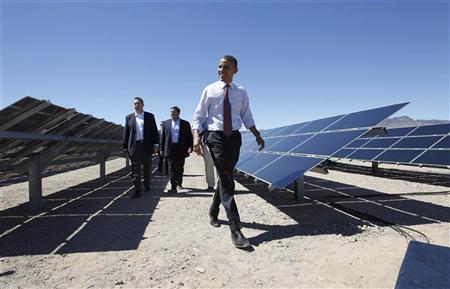(Reuters) – Three weeks ago, President
Barack Obama stood in front of a sea of gleaming solar panels in Boulder City, Nevada, to celebrate his administration’s
efforts to promote “green energy.”

Stretching row upon row into
the desert, the Copper Mountain Solar Project not far from Las Vegas provided an impressive backdrop for the
president.
Built on public land, the facility is the largest of its kind in the United States. Its 1 million solar
panels provide enough energy to power 17,000 homes.
And it employs just 10 people.
Three years after Obama
launched a push to build a job-creating “green” economy, the White House can say that more than 1 million drafty homes have
been retrofitted to lower heating and cooling costs, while energy generation from renewable sources such as wind and solar
has nearly doubled since 2008.
But the millions of “green jobs” Obama promised have been slow to sprout, disappointing
many who had hoped that the $90 billion earmarked for clean-energy efforts in the recession-fighting federal stimulus package
would ease unemployment – still above 8 percent in March.
Supporters say the administration over-promised on the jobs
front and worry that a backlash could undermine support for clean-energy policies in general.
“All of this stuff is
extraordinarily worthy for driving long-term economic transformation but extremely inappropriate to sell as a short-term job
program,” said Mark Muro, a clean-energy specialist at the Brookings Institution.
Others say the green-jobs push has
crowded out less fashionable efforts that would have put people back to work quickly.
“From my perspective it makes
more sense for us to arm our clients with the basic skills, rather than saying, ‘By golly, you will do something in the
green economy or you won’t work,'” said Janet Blumen, the head of the Foundation for an Independent Tomorrow, a Las Vegas
job-training organization that has seen positions in trucking and accounting go unfilled because training money had been
earmarked for green efforts.
A $500 million job-training program has so far helped fewer than 20,000 people find work,
far short of its goal.
Republicans, meanwhile, have seized on the failure of solar panel maker Solyndra, which
received a $535 million loan guarantee, to argue that White House allies have been the only ones who have benefited from the
green jobs push.
“He handed out tens of billions of dollars to green energy companies, including his friends and
campaign contributors at companies like Solyndra that are now bankrupt,” Republican presidential candidate Mitt Romney said
on April 4.
VARYING ESTIMATES
Backers of the notion of a “green collar” work force argue that earth-friendly
energy is a promising growth sector that could create a bounty of stable, middle-class jobs and fill the gap left by
manufacturing work that has moved overseas.
On the campaign trail in 2008, Obama promised that a $150 billion
investment would generate 5 million jobs over 10 years.
Obama included $90 billion in the American Recovery and
Reinvestment Act to weatherize drafty buildings, fund electric-car makers and encourage other clean-energy
efforts.
“We’ll put nearly half a million people to work building wind turbines and solar panels, constructing
fuel-efficient cars and buildings, and developing the new energy technologies that will lead to new jobs,” he said at a
wind-turbine plant in Ohio the day before he took office.
In December 2009, Vice President Joe Biden said the effort
would create 722,000 green jobs.
The White House said in November 2010 that its clean-energy efforts had generated
work for 225,000 people and would ultimately create a total of 827,000 “job years” – implying average annual employment of
around 200,000 over the four years of Obama’s presidential term.
White House officials stand by that estimate and say
job creation is only one aspect of the clean-energy push.
“We have a record of success that has created tens of
thousands of jobs and is ensuring that America is not ceding these industries to countries like China,” White House spokesman Clark Stevens said. “Thanks to the
investments we’ve made, these industries will continue to grow, along with the jobs they create.”
One problem is
that, unlike other elements of the Recovery Act that injected money into the economy quickly, efforts to develop high-speed
rail or electric-car batteries Obama also promoted could take a decade or longer to yield dividends.
Gains in the
sector don’t necessarily lead to wider employment.
The wind industry, for example, has shed 10,000 jobs since 2009
even as the energy capacity of wind farms has nearly doubled, according to the American Wind Energy Association. Meanwhile,
the oil and gas industry has added 75,000 jobs since Obama took office, according to Labor Department
statistics.
Federal agencies also have struggled to get stimulus money out the door in a timely manner, even for
prosaic efforts that help local governments reduce energy costs.
The rush of funding encouraged private-sector
participants to inflate their job-creation projections as they angled for a piece of the action, insiders say.
“They
were obviously just guessing,” said Robert Pollin, a University of Massachusetts professor and green-energy supporter who
helped the Energy Department sort through loan applications. “If an undergraduate gave me a paper of that quality I would
have probably given them a C or a C-plus.”
SLOW PROGRESS
The high-profile failures of companies that have
benefited from federal backing, such as Solyndra and Beacon Power Corp., have given ammunition to Republicans who paint the
effort as a costly boondoggle.
They also have targeted the $500 job-training program that aims to train workers for
skills they would need in a new “green economy.”
The program’s initial results were so poor that the Labor
Department’s inspector general recommended last fall that the agency should return the $327 million that remained
unspent.
The numbers have improved somewhat since then, but the department remains far short of its goal of placing
80,000 workers into green jobs by 2013.
By the end of 2011, some 16,092 participants had found new work in a “green”
field, according to the Labor Department – roughly one-fifth of its target. The program also helped employed workers upgrade
their skills.
Republican Senator Charles Grassley said the program had reached too few workers to be deemed a
success.
“The green jobs-training program just didn’t work. It was a poor investment of tax dollars,” Grassley said
in a prepared statement.
SHADES OF GREEN
The effort has been complicated by confusion over what exactly
constitutes a green job.
In March, the Labor Department estimated there were 3.1 million green jobs in the United
States as of 2010, using a broad definition that included everything from nuclear power-plant workers to regulators,
lobbyists and park rangers.
The Recovery Act used a narrower definition, focusing on wind, solar and other
renewable-energy industries and energy-efficiency efforts aimed at reducing consumption.
Using a definition similar to
the Labor Department’s, the Brookings Institution estimated that the Las Vegas region that includes the vast solar fields
sprouting around Boulder City supported 9,797 “clean jobs” in 2010, accounting for 1.2 percent of the region’s
employment.
Local officials don’t expect that figure to grow much.
“Will it add a significant number of jobs,
enough to make a real dent in our unemployment? No, I don’t see that happening,” said Darren Divine, vice president for
academics at the College of Southern Nevada.
The fields of healthcare, education and technology are likely to provide
the best employment prospects in the years to come, he said.
PLUGGING THE GAPS
The much-touted home
weatherization program has upgraded more than 1 million houses and provided work for about 20,000 people, as well as
generating business for suppliers, according to the White House.
But here as well, supply has outpaced demand. While
government spending has kept contractors busy upgrading low-income houses and public buildings, homeowners have been less
eager to spend their own money in a tumbling real estate market.
Contractors have fared better than the construction
industry as a whole but have not found as much work as hoped, said Greg Thomas, the chairman of the trade group Efficiency
First.
Les Lazareck, the head of Home Energy Connection in Las Vegas, estimated that fewer than one in four people he
has trained through a Recovery Act program now earn most of their income through weatherization work.
“There’s
definitely not enough demand,” he said. “The private market has been very slow.”
(Editing by David Lindsey and Philip Barbara)





